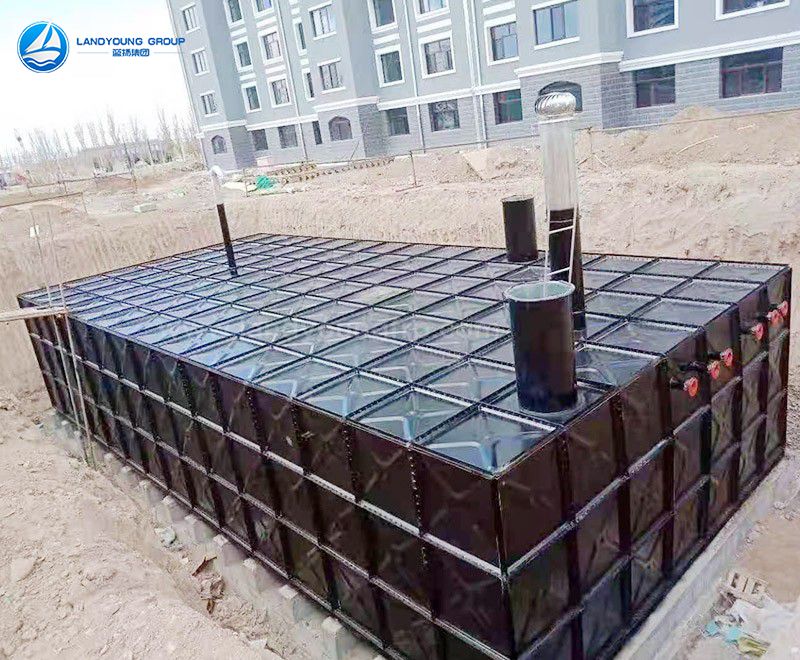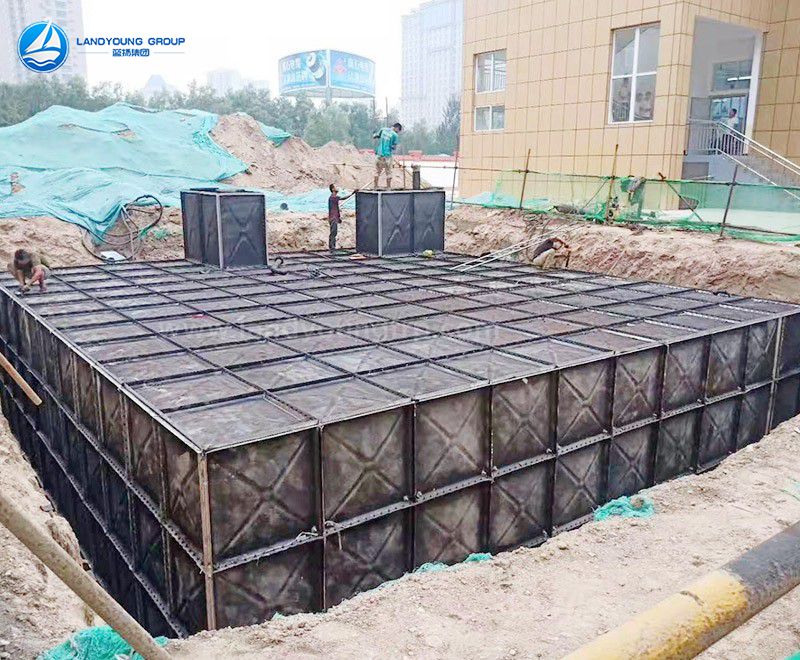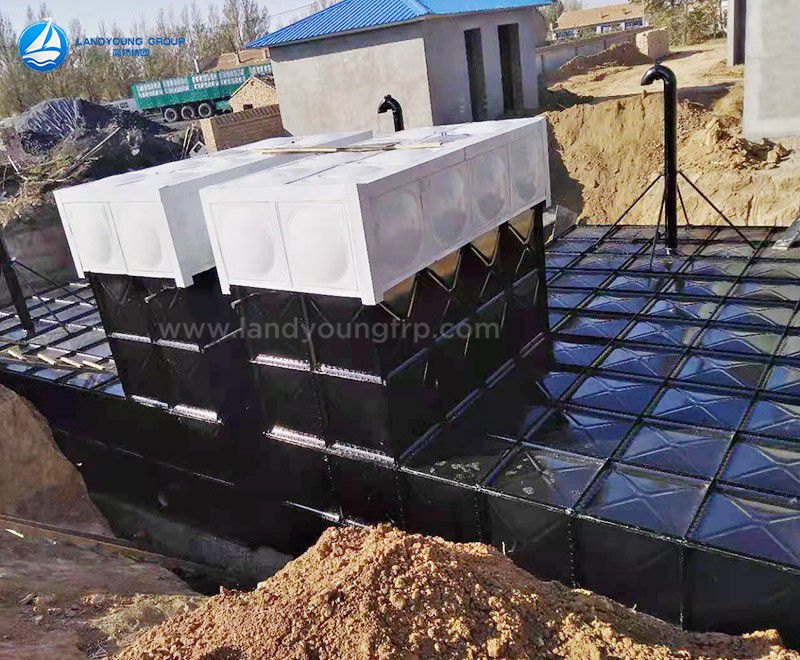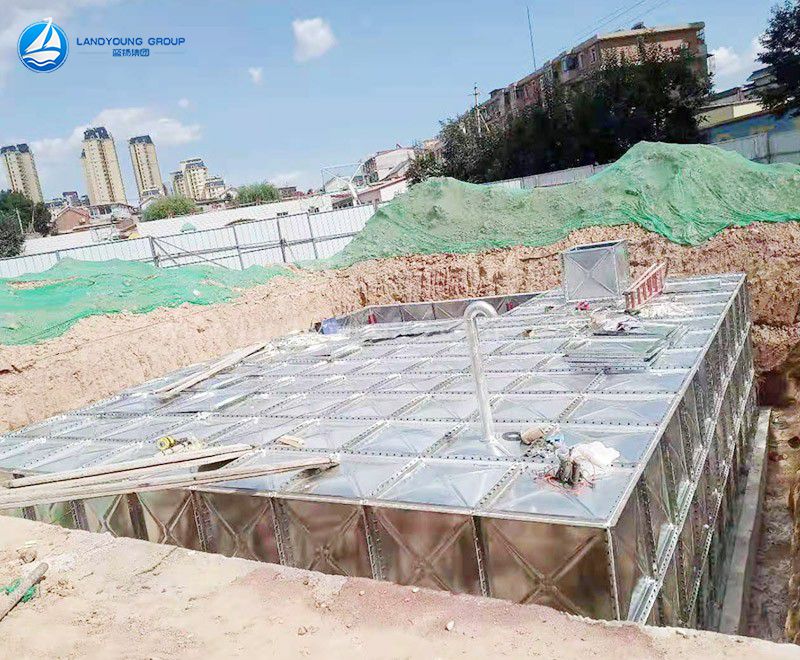sales@landyounggroup.com
+86 133 2318 2255




LANDYOUNG SGC underground water tank is made of hot-dip galvanized steel plate and stainless steel plate which are pressed and compounded by equipment to make a close fit to meet the requirements of strength of steel plate material and corrosion resistance of stainless steel.
S: It means stainless steel. Generally, the stainless steel in the compound is 304-2B, and the thickness is 0.4mm
G: It means galvanized steel plates, which is divided into cold galvanized and hot-dipped galvanized steel. The thickness is generally 3.0mm
C: It means compounding. Put the stainless steel plate and galvanized steel plate on the punching bed, and stamp them at one time. The flanges are 90° angle welding and 45° angle non-welding
LANDYOUNG SGC underground water tank is made of hot-dip galvanized steel plate and stainless steel plate which are pressed and compounded by equipment to make a close fit to meet the requirements of strength of steel plate material and corrosion resistance of stainless steel.
● Areas where the water volume of the municipal water supply network cannot meet the needs of users.
● The municipal water supply pipe network can use the area where the water head is too low.
● Areas with excessive pressure fluctuations in the municipal water supply network.
● Areas with frequent water cuts.
● The area where the main pipe diameter of the municipal water supply pipe network is too small.
● Water for life and fire fighting in ordinary residences, commercial and residential buildings, office buildings, residential quarters, offices, hotels, schools, etc.
● Fire water for industrial and mining enterprises.
● No pump room
Save space, the water pump and pump room are placed on the water tank and fixed on the dedicated modules of the integrated pumping station. Only occupies 0.5m3-1m3 water tank volume.
● Easy site selection
The buried water tank is lined with stainless steel and galvanized sheet composite, and the surface is sprayed with anti-corrosion coating. It can be sold under the fish lawn or in some idle places.
● Easy to empty
Because this product is a long-axis fire pump, the impeller is directly submerged in the water without special exhaust air. As long as the liquid level in the water tank is within the specified liquid level, it can enter the fire-fighting state.
● Freeze cracking
The water tank is under the ground to avoid being damaged by freezing in winter.
● Large specifications
According to user needs, 1-200000m3 or even large water tanks can be assembled.
● High strength
The product structure design is designed by the steel structure engineer of the design institute, and the top pressure and lateral pressure are transmitted to the box body and then to the column support of the steel structure in the box body.
● Energy saving and environmental protection
The product fully meets the current national environmental protection standards and regulations.
● Water tank size:1m³-20000 m³
● Panel material: Hot dip galvanized steel plates and food grade stainless steel plates
● Panel size: 0.5*0.5m,1*0.5m,1*1m,1.5*0.5m, 1.5*1 m, the panel thickness is depends on tank height
● Connection type:Bolted assembled
● Foundation: Concrete foundation and U-steel bottom base
1. After pressing and forming, punching and forming are carried out through equipment to meet the assembling requirements of standard modules.
2. On site assembly, the foundation channel steel is selected from the national standard hot dip galvanized treatment, and each beam is assembled with a spacing of 1 meter.
3. Assemble in accordance with the drawings and technical requirements, assembled with hot dip galvanized bolts and environmentally friendly, water resistant and anti-aging rubber gaskets. After the water tank is assembled and formed, the ribs and the top column are installed. The bracing is made of hot dip galvanized, and the bracing is crosswise and horizontally within 1 meter. The top column adopts hot dip galvanized pipe uniformly sealed.
4. Install the external bolts of the pump room and the pump room according to the pump station, and use I-beam reinforcement inside the pump to achieve a good pressure bearing effect. After the installation is completed, check and accept it to ensure that all tightening is not omitted.
5. Clean up all remaining accessories and litter in the water tank.
6. Backfill the soil and make site preparations
1. Before the SGC underground water tank is backfilled, the water in the pit must be pumped out to ensure that there is no water in the pit;
2. The soil used for backfilling soil must be fine, no dross, no stones:
3. When backfilling the soil, the excavator must be 2 meters away from the water tank, and the excavator cannot walk above the water tank;
4. When the SGC underground water tank is backfilled, the soil must be added from the surroundings, and the soil shall be added up in a circle of 50cm until it is parallel to the ground.
Q: What is an SGC underground water tank?
A: An SGC underground water tank refers to a type of water storage system that is installed underground. It is commonly used to collect and store rainwater or groundwater for various purposes, such as irrigation, firefighting, or household use.
Q: What materials are used in the construction of an SGC underground water tank?
A: SGC underground water tanks are commonly constructed using materials such as hot dip galvanized steel plates and stainless steel plates. These materials are chosen for their durability, strength, and resistance to corrosion and leakage.
Q: Are SGC underground water tanks environmentally friendly?
A: Yes, SGC underground water tanks can be considered environmentally friendly. They promote water conservation by collecting and storing rainwater or groundwater that would otherwise go to waste. By utilizing harvested water for various purposes, these tanks reduce the strain on freshwater sources and contribute to sustainable water management practices.
Q: Can an SGC underground water tank be used for drinking water?
A: While SGC underground water tanks can store water, it is essential to note that the suitability of the stored water for drinking purposes depends on various factors, including the quality of the source water, the tank's construction materials, and the maintenance practices. If the tank is specifically designed and treated for potable water storage, it can be used for drinking water. However, it is recommended to consult local regulations and guidelines to ensure compliance with safety standards for drinking water storage and treatment.
Q: How do I maintain an SGC underground water tank?
A: Regular maintenance is crucial to ensure the optimal functioning of an SGC underground water tank. Some maintenance tasks include:
Regular inspection: Check for signs of leakage, cracks, or damage to the tank structure.
Cleaning: Periodically clean the tank to remove any sediment, debris, or microbial growth that may accumulate.
Filter maintenance: If the tank is equipped with filters, clean or replace them as recommended by the manufacturer.
Pump and pipe maintenance: Inspect and maintain the pump and pipes connected to the tank to ensure proper water flow and prevent blockages.
Water quality testing: Regularly test the stored water to ensure its safety and potability.
Overflow management: Ensure that the overflow system is functioning correctly to prevent waterlogging or damage to the tank and its surroundings.
It is advisable to refer to the manufacturer's guidelines and consult professionals for specific maintenance requirements based on the tank type and local conditions.
Q: Can an SGC underground water tank be relocated?
A: Relocating an SGC underground water tank can be challenging and costly due to the excavation and construction involved. It is generally not recommended unless there are compelling reasons to do so. If relocation is necessary, it is best to consult with experts or professionals experienced in such tasks to assess the feasibility and ensure the tank's structural integrity during the process.
Q: Are there any legal considerations for installing an SGC underground water tank?
A: Yes, the installation of an SGC underground water tank may be subject to local regulations, permits, and building codes. It is important to consult with local authorities or relevant agencies to determine any legal requirements, including obtaining necessary permits and adhering to specific guidelines for installation, usage, and maintenance of underground water storage systems. Compliance with these regulations helps ensure the safety, environmental sustainability, and longevity of the tank.